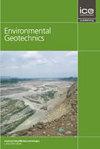Simultaneous Biocementation and Compaction of a Soil to Avoid the Breakage of Cementitious Structures during the Execution of Earthwork Constructions
IF 2.2
4区 工程技术
Q3 ENGINEERING, GEOLOGICAL
引用次数: 1
Abstract
This research focuses on the potential for microbial treatment to stabilize compacted soils, which are often utilized in earthwork projects. A silt–clay sand was used to describe a particular kind of soil. The suggested remedy makes use of the soil’s naturally occurring urea and Ca2+, as well as microorganisms introduced to the compaction water. Two alternative initial water-content types were examined: those on the dry side and those close to the ideal Proctor conditions. Bacillaceae microorganisms were used to induce microbial CaCO3 precipitation and improve the hydraulic and mechanical properties of the compacted soil. The samples were biotreated and immediately compacted, so that the precipitation of calcium carbonate during the curing process took place in the contact areas between the particles (biocementation) and in the pore space (bioclogging). A set of techniques were used to study the ageing effects, such as the water-retention curve by dew-points psychrometer, mercury porosimetry intrusion, permeability, ultrasonic pulse velocity, resonant column, and unconfined and tensile-compression tests. During the ageing, it was observed that the bacterial activity consumed water for the hydrolysis of urea and other intermediate reactions to precipitate CaCO3. This process resulted in a retraction of the microstructure and a change in the macrostructure. The bioclogging phenomenon was more evident in the soil microstructure, while the biocementation process was easier to observe in the macrostructure. The suction’s effects on the soil stiffness were studied in detail, and a significant increase was detected. Despite these water-content losses, which caused soil stiffening by increasing the suction, it was still feasible to identify the gradual rise in small-strain stiffness throughout incubation. The unconfined and tensile-compression tests showed a similar progressive increase in terms of peak compressive and peak splitting strength during the incubation. These results are of interest when microbiological treatments are applied in soils to produce cementitious materials, with the present investigation demonstrating a complete study of their geotechnical behaviour.在土方施工过程中,同时进行生物胶结和压实以避免胶结结构的破坏
本研究的重点是微生物处理稳定压实土壤的潜力,这通常用于土方工程项目。粉质粘土砂被用来描述一种特殊的土壤。建议的补救措施利用土壤中天然存在的尿素和Ca2+,以及引入压实水的微生物。检查了两种可选的初始含水量类型:干燥侧的和接近理想普罗克特条件的。利用芽孢杆菌科微生物诱导微生物CaCO3沉淀,改善压实土的水力力学性能。样品经过生物处理并立即压实,因此在固化过程中碳酸钙的沉淀发生在颗粒之间的接触区域(生物胶结)和孔隙空间(生物堵塞)。采用露点湿度计保水曲线、汞孔侵入、渗透性、超声脉冲速度、共振柱、无侧限和拉压试验等技术研究了老化效应。在老化过程中,观察到细菌的活性消耗了尿素水解和其他中间反应的水来沉淀CaCO3。这一过程导致微观结构的收缩和宏观结构的变化。土壤微观结构中生物堵塞现象更为明显,而宏观结构中生物胶结过程更容易观察到。详细研究了吸力对土体刚度的影响,发现吸力对土体刚度有明显的增加。尽管这些含水量损失通过增加吸力导致土壤变硬,但仍然可以确定在孵育过程中小应变刚度逐渐上升。无侧限和拉压试验表明,在孵育期间,峰值压缩强度和峰值劈裂强度也有类似的逐渐增加。当微生物处理应用于土壤以生产胶凝材料时,这些结果是有趣的,目前的调查显示了对其岩土力学行为的完整研究。
本文章由计算机程序翻译,如有差异,请以英文原文为准。
求助全文
约1分钟内获得全文
求助全文
来源期刊

Environmental geotechnics
Environmental Science-Water Science and Technology
CiteScore
6.20
自引率
18.20%
发文量
53
期刊介绍:
In 21st century living, engineers and researchers need to deal with growing problems related to climate change, oil and water storage, handling, storage and disposal of toxic and hazardous wastes, remediation of contaminated sites, sustainable development and energy derived from the ground.
Environmental Geotechnics aims to disseminate knowledge and provides a fresh perspective regarding the basic concepts, theory, techniques and field applicability of innovative testing and analysis methodologies and engineering practices in geoenvironmental engineering.
The journal''s Editor in Chief is a Member of the Committee on Publication Ethics.
All relevant papers are carefully considered, vetted by a distinguished team of international experts and rapidly published. Full research papers, short communications and comprehensive review articles are published under the following broad subject categories:
geochemistry and geohydrology,
soil and rock physics, biological processes in soil, soil-atmosphere interaction,
electrical, electromagnetic and thermal characteristics of porous media,
waste management, utilization of wastes, multiphase science, landslide wasting,
soil and water conservation,
sensor development and applications,
the impact of climatic changes on geoenvironmental, geothermal/ground-source energy, carbon sequestration, oil and gas extraction techniques,
uncertainty, reliability and risk, monitoring and forensic geotechnics.
 求助内容:
求助内容: 应助结果提醒方式:
应助结果提醒方式:


